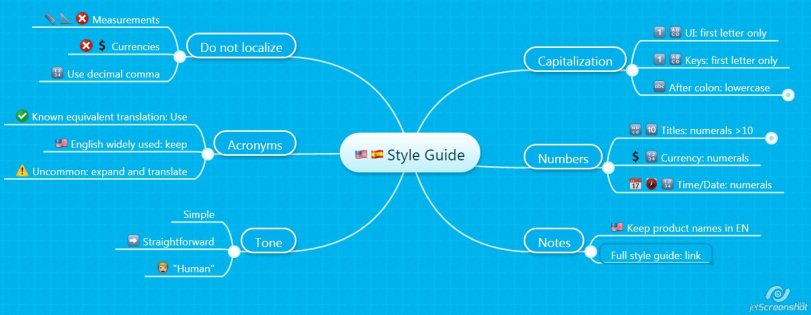This is going to be a very short and straight-to-the-point post just because the idea I want to share is incredibly simple. However, in my opinion, quite powerful.
If you have been in the localization industry for some time, you are familiar with style guides. If you are new to the translation world, style guides are documents that lay out the rules to be followed for a project or program. Style guides provide instructions on how to deal with things like numbers, capitalization, product names, user interface options, currency, punctuation, etc.
These rules are important because consistency is important: you want translators, editors, reviewers to use a similar approach; companies want to have a consistent voice to reach their audience.
Now, the problem with style guides is that they are hard to work with. Some are very lengthy, too detailed. But the main problem, as I see it, is the way in which the information is organized. For example, if you compare a table and a chart, it is obvious that the visual component of the chart makes it easier for the human brain to understand it. I encourage you to take a look at Visualizing Translation Quality Data for more interesting information on this.

I believe a similar concept can be applied to style guides. Mind maps are visual representations of data. They provide a simple way to visually organize information: usually, the core idea is in the center of the map, and lines connect new ideas. Each node is a potential starting point of a concept. Mind maps are also great to organize information – ideas that are related originate from the same node or can be connected with arrows.You can see ideas linked in a logical way.
Let’s take a look at an example: I turned a ~20-page style guide into the following 6-node mind map. The main idea is in the center of the map. For each of the main sections in the style guide, I created a node. From those nodes, I summarized the main ideas as much as possible. Also, since visuals are key, when relevant I added an icon, which actually helps you understand the idea at a glance. Product names + US flag = leave in English.

Now, only in very specific cases, a mind map can replace a style guide. Why? Because style guides need to be specific, they need to cover all the angles. I believe style guides and mind maps work well together. In a typical scenario, a translator would read the style guide once, and then use the mind map as a quick reference. Just looking at the map, rather than scanning a long document to find the information you need, is a much more efficient approach.
If you want to check out this mind map, here’s a link. I created it with a tool call Mindmeister, which you can use for free.
I have worked in software localization for 6+ years. I’ve also worked as a project manager for Spanish translations. I even created a Spanish style guide for the agency I was working for.
I’m also familiar with mind maps. They can be nice-looking as infographics or as starting points for discussion, analysis or execution, but unless you’re using a mindmap as a graphic TOC (table of contents), a mindmap can’t replace a style guide because it has different funcitons.
Now, the purpose of a style guide is NOT consistency but proper style, whether it’s financial writing style or procedural/instructional style, which is common in technical manuals. A great deal of the contents of a style guide has to do with language structure, which should be second nature to a software or technical translator already. That’s probably why many of us translators find style guides repetitive or obvious.
There is still the problem of redundant information, disorganized information and crossed purposes in many technical style guides. One of the sources of this problem is that the style guide is conceived from a monolinguistic viewpoint (English, in this case). Most style guides I’ve seen betray a lack of knowledge of internationalization.
LikeLike
Thanks for your comment. Let me just clarify that when I say style guides help achieve consistency, I’m referring to stylistic consistency, not segment-level or term-level consistency. If you have 10 translators in your team, you don’t want half of them using a formal tone and the other half going for informal.
I’ve been in localization since 2003, and as a Language Lead and Language Manager I have put together myself many, many style guides. Even when some language aspects should be second nature (I agree with that), you also need to consider client preferences. I’m sure you dealt sometimes with clients that have every specific language requirements and, in spite of your suggestions, they prefer not to change some things. I guess we could say then that the exceptions are they key points from a style guide for more experienced translators.
LikeLike